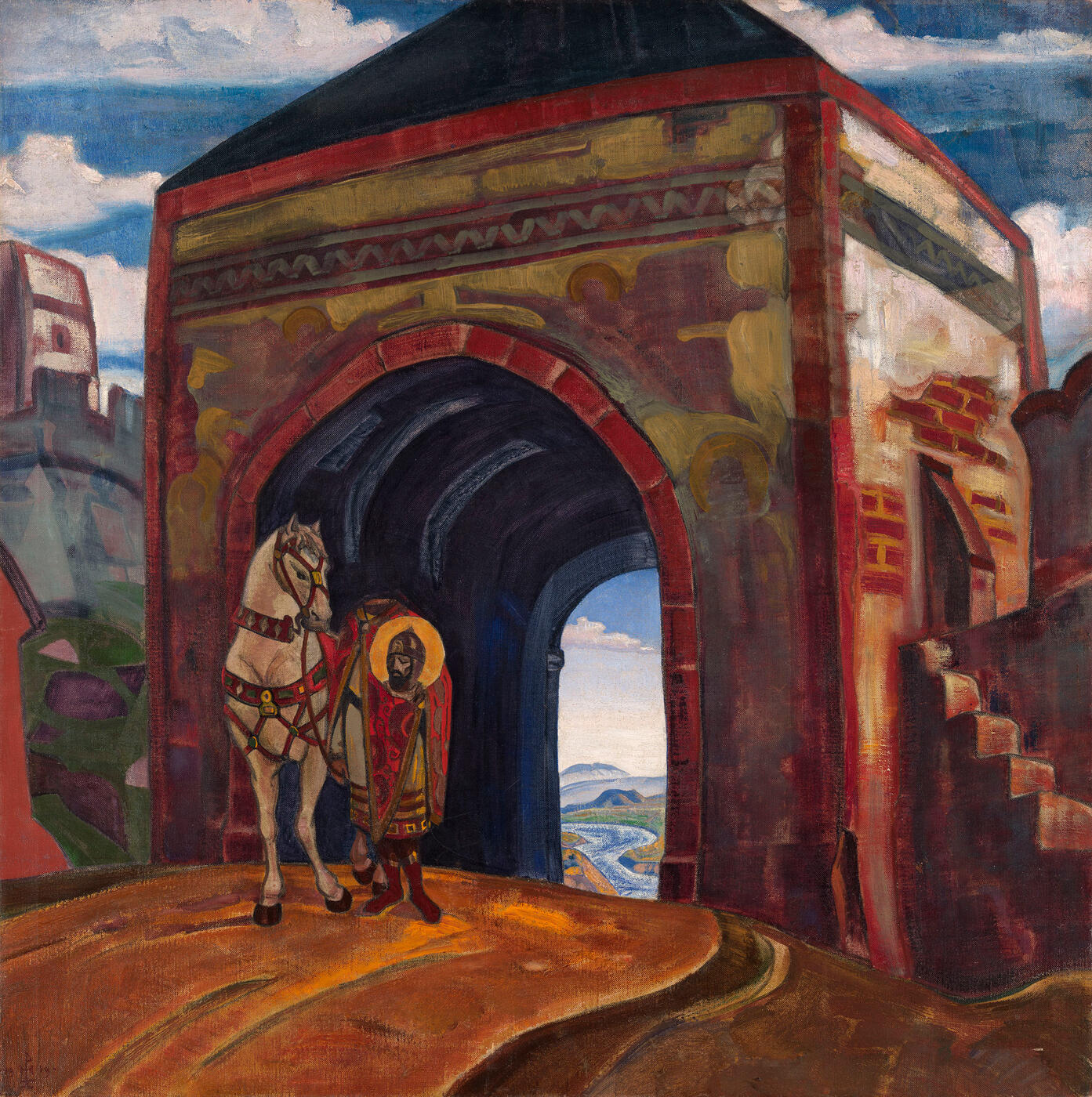5 June 2019 Important Russian Art Auctions, at Asia House
5 June 2019

* 40. ROERICH, NICHOLAS (1874–1947)
St Mercurius of Smolensk, signed with a monogram and dated 1919.
Oil on canvas, 91.5 by 91.5 cm.
200,000–300,000 GBP
Provenance: Collection of B.H. Kean, New York.
Icons, Russian Pictures and Works of Art, Sotheby’s London, 15 December 1993, lot 29.
Acquired at the above sale by the present owner.
Private collection, USA.
Authenticity of the work has been confirmed by the expert O. Glebova.
Literature: Nicholas Roerich, vol. 1, Samara, Agni Publishing House, 2008, p. 230, pl. 265, illustrated; p. 661, No. 265, listed with incorrect date 1918.
Related Literature: For similar work, see A. Yaremenko, Nicholai Konstantinovich Roerich, His Life and Creations During the Past Forty Years, 1889–1929, New York, Central Book Trading Company, 1931, p. 13, pl. 60, illustrated; p. 35, mentioned in the text.
Nicholas Roerich, vol. 1, Samara, Agni Publishing House, 2008, p. 231, pl. 266, illustrated.
St Mercurius of Smolensk by Nicholas Roerich belongs to his large series of works dedicated to Russian saints. This series is a particularly important part of the artist’s oeuvre.
Roerich considered the First World War, which had engulfed Europe, as a global catastrophe. Empires fell, whole cities were laid waste and some of the most valued monuments of European history, repositories of the memory of many generations, were reduced to ashes. In that turbulent time, the artist turned to the history of the Tartar-Mongol invasions, the ruthless destructiveness of which reminded him of the contemporary events in Europe. Roerich created a series of works devoted to holy warriors and intercessors who defended Russia and the Christian faith at a time when all hope of rescue seemed vain. So from the fear and despair of The Doomed City (1914) and Glow (1914) Roerich moves on to hope and the expectation of salvation, as expressed in Prokopy the Righteous Diverts the Cloud of Stones from Veliky Ustyug (1914), Saint Nikolai of Mozhaisk (1916), Saint Mercurius of Smolensk (1918) and The Saints Boris and Gleb (1919).
Two versions of St Mercurius of Smolensk are known. The first, painted in 1918, from the collection of Dmitry Rubinstein, was reproduced in 1931 in a monograph devoted to the works of Roerich. In this version, the protagonist is met as he enters the city by an angelic choir, which the artist places in the upper right section of the composition. It should be noted that Roerich had three major solo exhibitions in 1918–1920 in Stockholm, Helsinki and London. Many works from these exhibitions were sold to museums and private collections; and it is possible that this prompted him to replicate his most important paintings. In 1919 Roerich created a new version of St Mercurius of Smolensk, which — as was often the case with his replications — he did not enter into the list of original works.
Initially, the new version was conceived as an exact replica of the 1918 composition. Infrared photography reveals the preparatory drawing, in which the figures of angels at the top right and a palace with a chapel to the left of the gates are clearly visible. But as the work progressed, Roerich decided to do something different. He removed the sketched choir and clouds and painted a mural on the facade of the gates, which depicted two angels sounding trumpets in honour of the hero. Thus, the heavenly host was made less obvious, intended to be noticed only by a more perceptive viewer. This rearrangement led to a reworking of the whole composition. The architecture on the left side of the original picture, which teemed with detail, is replaced by a more laconic image of a fortress tower. Overall, while the atmosphere on the 1918 version was jubilant (the colourful city, billowing, foam-like clouds, and angels in azure raiment), the version of 1919 is executed in a more austere and restrained manner, which Roerich deemed more appropriate to the nature of the martyrdom of Mercurius, who paid with his life for the rescue of Smolensk.
However, structural changes to the composition and, more importantly, the degree to which Roerich reinterpreted the emotional content of the painting, allow to view the offered work is an authentic version that reveals new facets of the existing subject. St Mercurius of Smolensk is an outstanding work from Nikolai Roerich’s Sancta series, one of the most important components of his oeuvre, which is now almost entirely held in museum collections.
We are grateful to the expert Olga Glebova, art historian, for providing additional catalogue information.
Notes on symbols:
* Indicates 5% Import Duty Charge applies.
Ω Indicates 20% Import Duty Charge applies.
§ Indicates Artist's Resale Right applies.
† Indicates Standard VAT scheme applies, and the rate of 20% VAT will be charged on both hammer price and premium.